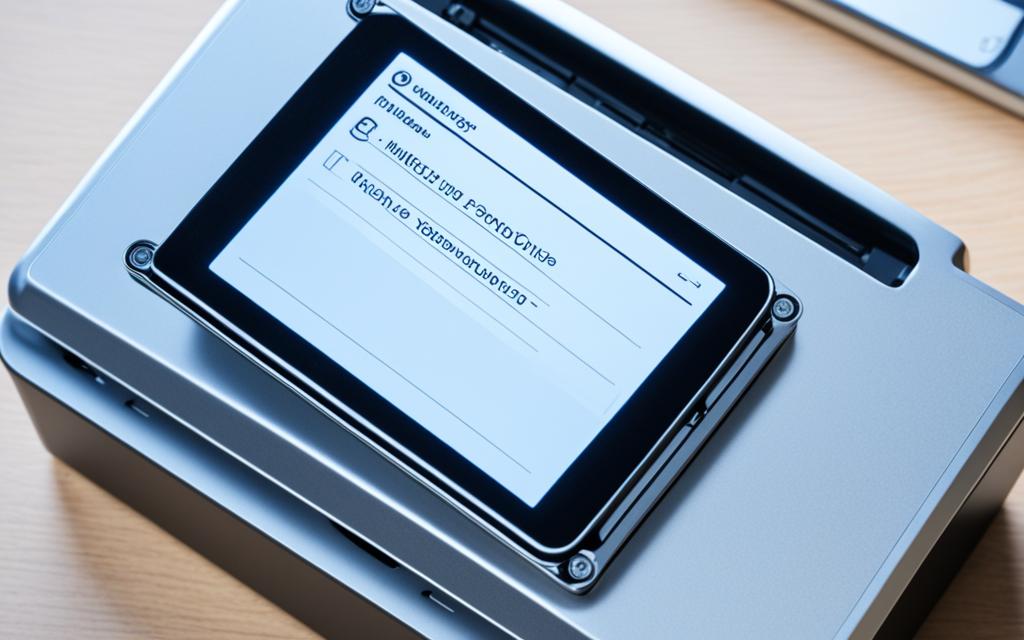Table of Contents
In today’s world, handling your digital data is key. One important task is removing Time Machine backups from an external hard drive. Time Machine is vital for keeping your files safe. It automatically saves your files every hour, every day, and every week. This includes your important documents, photos, and apps. But, as these backups build up, you might worry about running out of space. This leads to the need for removing some backups without losing data security.
Time Machine is designed to delete old backups when your Mac runs low on space. This means it helps manage the backup process, but you can do more. By taking action to manage your external hard drive, you can improve its performance and save space1. This guide will show you how to handle your backups better. It helps you free up space on your external drive while keeping your important data safe.
Key Takeaways
- Time Machine backs up files automatically, allowing easy restoration.
- Regularly assess your backups to optimise available space on your external hard drive.
- Utilising the Time Machine app is generally the best way to delete old backups safely.
- Be aware of the manual snapshot deletion process if you need to manage your storage rigorously.
- Disabling automatic backups temporarily may be a good option when short on space.
Introduction to Time Machine Backups
Time Machine is the go-to backup solution for macOS. It lets users easily protect their data. It saves incremental backups, so you can get back files easily. Time Machine automatically saves hourly backups for 24 hours, daily for the past month, and weekly for all past months. This keeps your data safe and ready to retrieve2.
Understanding Time Machine and Its Functionality
Time Machine has a neat trick – it only backs up files that have changed since the last backup. This makes backups faster and saves space3. You can restore these backups on the same Mac or a different one, which adds flexibility in recovering your data4. This feature is key in reducing the effects of data loss, no matter the reason.
Importance of Regular Backups
Using Time Machine for regular backups is vital. It guards against unexpected data loss and keeps essential files secure and within reach. Since storage can get filled quickly with incremental backups, managing your backups is important4.
For the best results, you might use more than one external drive or try disk rotation. These strategies boost data security. They offer peace of mind in our digital age3.
Identifying Redundant Time Machine Backups
It’s key to manage your backups to save space on your external drive. Start by figuring out your backup needs based on use. Know how many backups you have and why they matter. This helps you decide what to keep5. Time Machine makes hourly, daily, and weekly backups. This way, you keep a complete history of your files and apps. Many users like to have some control over which backups to hold onto or let go.
Assessing Your Backup Needs
When thinking about what backups you need, look at your files and apps. Backups keep important stuff like music, documents, and photos5. By reviewing them, you can tell which backups are key and which ones you can delete. Knowing how often and when backups happen helps you identify unnecessary ones. This lets you make your backup process better by keeping only what you really need.
How to Check Available Space on Your External Drive
It’s easy to see how much space you have left on your drive. Use macOS tools to keep an eye on storage. Open Finder, pick your drive, and see its capacity. If it’s getting full, you might need to tweak your Time Machine settings and delete old backups. Remember, Time Machine will get rid of old backups for you when space runs out1. Yet, there might be times when you’ll want to manually clear out space. This helps keep important files while making room for more.
How to Remove Time Machine from External Hard Drive
Begin by connecting your hard drive to your Mac. Then, decide which backups you want to remove. This backup removal clarity prevents losing important data. It’s crucial to know that turning off Time Machine is simple, but understanding its effects is key to keeping your data safe.
Preparation for Backup Removal
Check if your external drive uses APFS format. This is required for Time Machine backups. If you have backups on drives not using APFS, you might face problems deleting them. Use Disk Utility to check and manage your drive’s format before deleting anything.
Steps to Disengage Time Machine from Backup Drive
Open Time Machine in System Preferences. To stop using your drive for backups, select it and hit the ‘-‘ button. If you want more control, Terminal commands are useful. Type tmutil listbackups to see what you can delete. To remove specific ones safely, use tmutil delete -d /path/to/backup/drive -t timestamp_of_backup. Be careful, as manual deletion might cause problems.
Following these steps carefully helps avoid data loss or damage. Using Disk Utility after deletion gives your drive a new beginning. Consider CleanMyMac X for easy backup management.
To learn more about handling Time Machine backups, check the detailed guide here6. Following these steps correctly will safeguard your data and allow effective backup management57.
Methods for Deleting Time Machine Backups
Managing your Time Machine backups is key to using your Mac’s storage well. You can choose from several methods to remove Time Machine backups. Each method has good and bad points. Knowing them lets you control your data better and avoid storage problems.
Using the Time Machine App for Safe Deletion
The Time Machine app is a user-friendly way to delete backups. Through its interface, you can pick which backups to delete. This keeps the rest of your data safe. It’s a good way to make sure you don’t lose important files by mistake.
Erasing Backups via Finder: Pros and Cons
Deleting Time Machine backups using Finder might look easy, but it has dangers. You could mess up the backup system. This can cause loss of data if you’re not careful. Think carefully about this option, especially with important files.
Utilising Terminal for Advanced Backup Management
Terminal is great for those who know their way around advanced commands. It uses commands like `tmutil listbackups` and `tmutil delete` for specific tasks. Be cautious, as wrong commands can delete data you wanted to keep. If you’re going to use Terminal, make sure you understand it well. For tips on secure backup methods, see the detailed guide here for more information8.
FAQ
How do I know if my Time Machine backups are consuming too much space?
To find out, select your external drive in Finder and press Command + I. This action will show how much space you have left. Then, look at your backups to spot any that are unnecessary and can be deleted.
What should I do before removing Time Machine backups?
First, make sure your external drive is connected correctly. Next, figure out which backups are important and which ones you can remove. This helps avoid losing important files by mistake.
Does Time Machine automatically delete older backups?
Indeed, Time Machine does remove old backups to free up space. But sometimes, you might need to delete some manually if you notice your storage filling up too quickly.
What are the risks of manually deleting backups using Finder?
Deleting backups in Finder can accidentally get rid of critical data. This is risky with the way Time Machine’s incremental backups work. It’s safer to remove backups using the Time Machine app.
How can I safely delete Time Machine backups?
The best way to delete Time Machine backups is by using the Time Machine app. This lets you choose specific backups to delete safely. If you’re an advanced user, you can use Terminal, but be careful to prevent losing important files.
What is the purpose of using Terminal for backup management?
Using Terminal gives you more control over your Time Machine backups. It’s great for expert users. But, it’s crucial to know what you’re doing to avoid errors. Stick to commands like `tmutil listbackups` and `tmutil delete` carefully.
Source Links
- https://mackeeper.com/blog/delete-time-machine-backups/ – How to Delete Time Machine Backups
- https://support.apple.com/en-gb/104984 – Back up your Mac with Time Machine – Apple Support (UK)
- https://www.backblaze.com/blog/use-multiple-hard-drives-time-machine/ – How to Use Time Machine Backup with Multiple Drives and the Cloud
- https://ewen.mcneill.gen.nz/blog/entry/2023-07-11-moving-and-expanding-macos-time-machine-backups/ – Moving and expanding macOS Time Machine Backups
- https://cleanmymac.com/blog/delete-time-machine-backups – How to delete Time Machine backups and snapshots: full guide
- https://derflounder.wordpress.com/2022/07/01/removing-unwanted-time-machine-backups-from-apfs-formatted-time-machine-backup-drives-on-macos-monterey/ – Removing unwanted Time Machine backups from APFS-formatted Time Machine backup drives on macOS Monterey
- https://www.lifewire.com/delete-time-machine-backups-5219464 – How to Delete Time Machine Backups
- https://www.easeus.com/mac-backup-recovery/how-to-delete-old-time-machine-backups.html – How to Delete Old Time Machine Backups in 3 Possible Way








